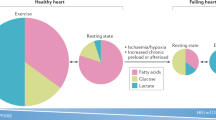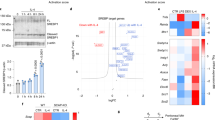Abstract
The peroxisome proliferator-activated receptor-γ (PPAR-γ) is a ligand-dependent nuclear receptor that has been implicated in the modulation of critical aspects of development and homeostasis, including adipocyte differentiation1, glucose metabolism2,3 and macrophage development and function4,5,6. PPAR-γ is activated by a range of synthetic and naturally occurring substances, including antidiabetic thiazolidinediones2,3, polyunsaturated fatty acids7, 15-deoxy-Δ12,14prostaglandin J2 (refs 8, 9) and components of oxidized low-density lipoprotein, such as 13-hydroxyoctadecadienoic acid (13-HODE) and 15-hydroxyeicosatetraenoic acid (15-HETE)10. However, the identities of endogenous ligands for PPAR-γ and their means of production in vivo have not been established. In monocytes and macrophages, 13-HODE and 15-HETE can be generated from linoleic and arachidonic acids, respectively, by a 12/15-lipoxygenase that is upregulated by the TH2-derived cytokine interleukin-4 (ref. 11). Here we show that interleukin-4 also induces the expression of PPAR-γ and provide evidence that the coordinate induction of PPAR-γ and 12/15-lipoxygenase mediates interleukin-4-dependent transcription of the CD36 gene in macrophages. These findings reveal a physiological role of 12/15-lipoxygenase in the generation of endogenous ligands for PPAR-γ, and suggest a paradigm for the regulation of nuclear receptor function by cytokines.
This is a preview of subscription content, access via your institution
Access options
Subscribe to this journal
Receive 51 print issues and online access
$199.00 per year
only $3.90 per issue
Buy this article
- Purchase on Springer Link
- Instant access to full article PDF
Prices may be subject to local taxes which are calculated during checkout




Similar content being viewed by others
References
Tontonoz, P., Hu, E. & Spiegelman, B. M. Stimulation of adipogenesis in fibroblasts by PPARγ2, a lipid-activated transcription factor. Cell 79, 1147–1156 (1994).
Lehmann, J. M.et al. An antidiabetic thiazolidinedione is a high affinity ligand for peroxisome proliferator-activated receptor-γ (PPARγ). J. Biol. Chem. 270, 12953–12956 (1995).
Willson, T. M.et al. The structure–activity relationship between peroxisome proliferator-activated receptor γ agonism and the antihyperglycemic activity of thiazolidinediones. J. Med. Chem. 39, 665–668 (1996).
Tontonoz, P., Nagy, L., Alvarez, J. G. A., Thomazy, V. A. & Evans, R. M. PPARγ promotes monocyte/macrophage differentiation and uptake of oxidized LDL. Cell 93, 241–252 (1998).
Ricote, M., Li, A. C., Willson, T. M., Kelly, C. J. & Glass, C. K. The peroxisome proliferator-activated receptor-γ is a negative regulator of macrophage activation. Nature 391, 79–82 (1998).
Jiang, C., Ting, A. T. & Seed, B. PPAR-γ agonists inhibit production of monocyte inflammatory cytokines. Nature 391, 82–86 (1998).
Kliewer, S. A.et al. Fatty acids and eicosanoids regulate gene expression through direct interactions with peroxisome proliferator-activated receptors α and γ. Proc. Natl Acad. Sci. USA 94, 4318–4323 (1997).
Kliewer, S. A.et al. Aprostaglandin J2metabolite binds peroxisome prolifator-activated receptorγ and promotes adipocyte differentiation. Cell 83, 813–819 (1995).
Forman, B. M.et al. 15-Deoxy-Δ12,14-prostaglandin J2is a ligand for the adipocyte determination factor PPARγ. Cell 83, 803–812 (1995).
Nagy, L., Tontonoz, P., Alvarez, J. G. A., Chen, H. & Evans, R. M. Oxidized LDL regulates macrophage gene expression through ligand activation of PPAR-γ. Cell 93, 229–240 (1998).
Conrad, D. J., Kuhn, H., Mulkins, M., Highland, E. & Sigal, E. Specific inflammatory cytokines regulate the expression of human monocyte 15-lipoxygenase. Proc. Natl Acad. Sci. USA 89, 217–221 (1992).
Ricote, M.et al. Expression of the peroxisome proliferator-activated receptor γ (PPARγ) in human atherosclerosis and regulation in macrophages by colony stimulating factors and oxidized low density lipoprotein. Proc. Natl Acad. Sci. USA 95, 7614–7619 (1998).
Zhu, Y.et al. Structural organization of mouse peroxisome proliferator-activated receptor γ (mPPAR γ) gene: alternative promoter use and different splicing yield two mPPAR γ isoforms. Proc. Natl Acad. Sci. USA 92, 7921–7925 (1995).
Fajas, L., Fruchart, J. C. & Auwerx, J. PPARγ3 mRNA: a distinct PPARγ mRNA subtype transcribed from an independent promoter. FEBS Lett. 438, 55–60 (1998).
Yamamoto, S. Mammalian lipoxygenases: molecular structure and functions. Biochem. Biophys. Res. Commun. 1128, 117–131 (1992).
van Leyen, K., Duvoisin, R. M., Engelhardt, H. & Wiedmann, M. Afunction for lipoxygenase in programmed organelle degradation. Nature 395, 392–395 (1998).
Rankin, S. M., Parthasarathy, S. & Steinberg, D. Evidence for a dominant role of lipoxygenase(s) in the oxidation of LDL by mouse peritoneal macrophages. J. Lipid Res. 32, 449–456 (1991).
Benz, D. J.et al. Enhanced levels of lipoperoxides in low density lipoproteins incubated with murine fibroblasts expressing high levels of human 15-lipoxygenase. J. Biol. Chem. 270, 5191–5197 (1995).
Funk, C. D. The molecular biology of mammalian lipoxygenases and the quest for eicosanoid functions using lipoxygenase-deficient mice. Biochim. Biophys. Acta 1304, 65–84 (1996).
Kuhn, H. Biosynthesis, metabolization and biological importance of the primary 15-lipoxygenase metabolites 15-hydro(pero)xy-5Z,8Z,11Z,13E-eicosatetraenoic acid and 13-hydro(pero)xy-9Z,11E-octadecadienoic acid. Prog. Lipid Res. 35, 203–226 (1996).
Heydeck, D.et al. Interleukin-4 and -13 induce upregulation of the murine macrophage 12/15-lipoxygenase activity: evidence for the involvement of transcription factor STAT6. Blood 92, 2503–2510 (1998).
Scheidegger, K. J., Butler, S. & Witztum, J. L. Angiotensin II increases macrophage-mediated modification of low density lipoprotein via a lipoxygenase-dependent pathway. J. Biol. Chem. 272, 21609–21615 (1997).
Bogdan, C., Vodovotz, Y., Paik, J., Xie, Q.-W. & Nathan, C. Mechanism of suppression of nitric oxide synthase expression by interleukin-4 in primary mouse macrophages. J. Leukocyte Biol. 55, 227–233 (1994).
Yesner, L. M., Huh, H. Y., Pearce, S. F. & Silverstein, R. L. Regulation of monocyte CD36 and thrombospondin-1 expression by soluble mediators. Arterioscler. Thromb. Vasc. Biol. 16, 1019–1025 (1996).
Yamada, Y., Doi, T., Hamakubo, T. & Kodama, T. Scavenger receptor family proteins: roles for atherosclerosis, host defence and disorders of the central nervous system. Cell. Mol. Life Sci. 54, 628–640 (1998).
Endemann, G.et al. CD36 is a receptor for oxidized low density lipoprotein. J. Biol. Chem. 268, 11811–11816 (1993).
Savill, J. S., Hogg, N., Ren, Y. & Haslett, C. Thrombospondin cooperates with CD36 and the vitronectin receptor in macrophage recognition of neutrophils undergoing apoptosis. J. Clin. Invest. 90, 1513–1522 (1992).
Sun, D. & Funk, C. D. Disruption of 12/15-lipoxygenase expression in peritoneal macrophages. J. Biol. Chem. 271, 24055–24062 (1996).
Nolte, R. T.et al. Ligand binding and co-activator assembly of the peroxisome proliferator-activated receptor-γ. Nature 395, 137–143 (1998).
Sigal, E. C., Craik, C. S. & Highland, E. Molecular cloning and primary structure of human 15-lipoxygenase. Biochem. Biophys. Res. Commun. 157, 457–464 (1988).
Acknowledgements
We thank S. Blanchard (Glaxo Wellcome) for communicating results of the characterization of GW9662 before publication; T. Schneiderman for assistance with manuscript preparation; and J. Barnett for assistance in preparation of human peripheral blood monocytes. J.T.H. is supported by an NIH Postdoctoral Fellowship. J.S.W. is supported by an NIH Medical Scientist Training Program Grant to U. C. San Diego. M.R. is supported by a Postdoctoral Fellowship from the American Heart Association. C.J.K. and D.C. are clinical investigators of the Medical Research Service, Department of Veterans Affairs. C.K.G. is an Established Investigator of the American Heart Association. These studies were also supported by NIH grants to C.D.F. and C.K.G. and a Specialized Center of Research Grant in Atherosclerosis to J.L.W. and C.K.G.
Author information
Authors and Affiliations
Corresponding author
Rights and permissions
About this article
Cite this article
Huang, J., Welch, J., Ricote, M. et al. Interleukin-4-dependent production of PPAR-γ ligands in macrophages by 12/15-lipoxygenase. Nature 400, 378–382 (1999). https://doi.org/10.1038/22572
Received:
Accepted:
Issue Date:
DOI: https://doi.org/10.1038/22572
This article is cited by
-
Senescence-associated 13-HODE production promotes age-related liver steatosis by directly inhibiting catalase activity
Nature Communications (2023)
-
Tissue transglutaminase exacerbates renal fibrosis via alternative activation of monocyte-derived macrophages
Cell Death & Disease (2023)
-
Brain fatty acid and transcriptome profiles of pig fed diets with different levels of soybean oil
BMC Genomics (2023)
-
Male infertility and somatic health — insights into lipid damage as a mechanistic link
Nature Reviews Urology (2022)
-
Effects of oxidative stress caused by iron overload on arachidonic acid metabolites in MES23.5 cells
Journal of Biosciences (2022)
Comments
By submitting a comment you agree to abide by our Terms and Community Guidelines. If you find something abusive or that does not comply with our terms or guidelines please flag it as inappropriate.



